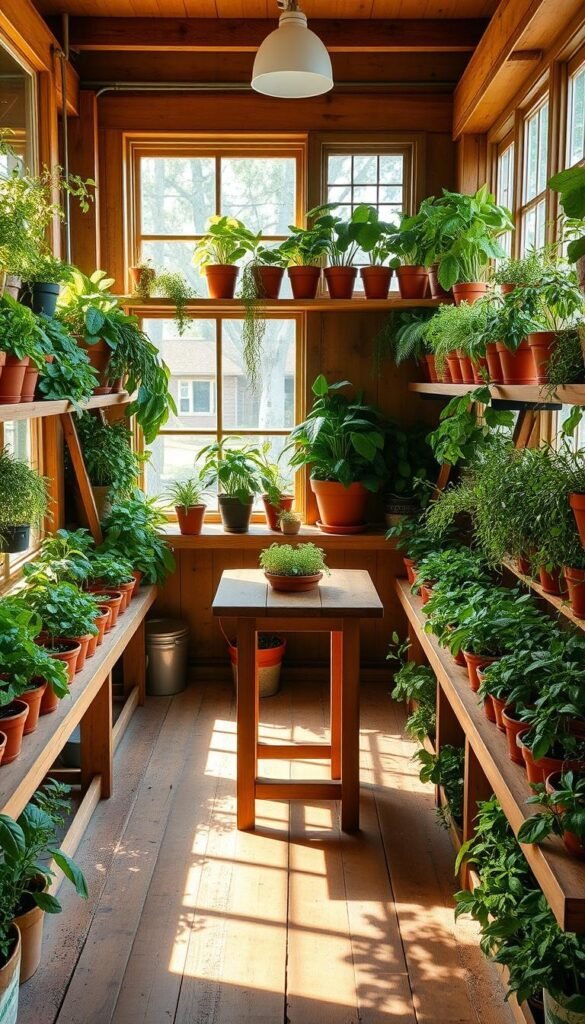Imagine plucking vibrant leaves seconds before they hit your skillet. Growing plants in your living space lets you boost meals instantly while adding life to your decor. Whether you’re making pesto or crafting cocktails, having greenery within arm’s reach changes how you interact with food.
You don’t need sprawling outdoor areas to cultivate flavor-packed greens. Many compact varieties thrive near sunny windows or under simple grow lights. Even better? These plants adapt well to containers, fitting neatly on shelves or counter corners.
Starting your own edible oasis costs less than weekly store-bought bundles. A $3 starter plant often yields months of harvests. You’ll taste the difference too – store-bought options can’t match the zing of leaves snipped moments before use.
This guide reveals how anyone can succeed with low-maintenance greenery. From selecting the right species to mastering watering rhythms, you’ll gain confidence quickly. Soon, you’ll wonder how you ever cooked without your personal flavor station.
Introduction to Indoor Herb Gardening
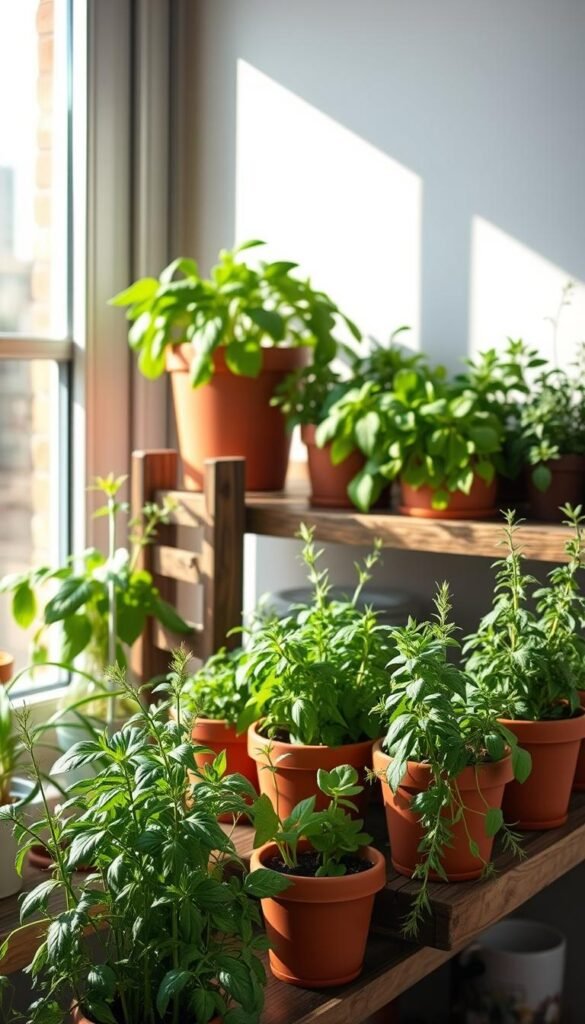
Discover how a sunny windowsill can become your personal spice rack, alive and growing. These compact plants thrive in confined spaces, making them perfect for apartments or homes with limited room. Best of all, you don’t need a green thumb to succeed – most varieties forgive occasional missed waterings.
Starting your edible collection requires just three essentials: containers with drainage, quality soil, and sunlight. Many popular culinary varieties like basil and mint adapt effortlessly to pots, growing happily in as little as 4-6 hours of daily light. Their modest root systems mean you can grow multiple herbs in a single planter.
New gardeners appreciate the instant rewards. Unlike vegetables that take months to mature, you can snip leaves for tonight’s dinner within weeks. Store-bought bundles wilt quickly, but homegrown options stay vibrant on their stems until needed.
The initial investment often costs less than $20 – about what you’d spend on pre-cut herbs in two months. As your confidence grows, expand your selection with unique varieties supermarkets rarely stock. Lemon thyme or purple basil add bursts of flavor you can’t buy in plastic clamshells.
With consistent care, these resilient plants produce year-round. They’ll transform how you cook, one freshly picked sprig at a time.
Why Choose an Indoor Herb Garden?
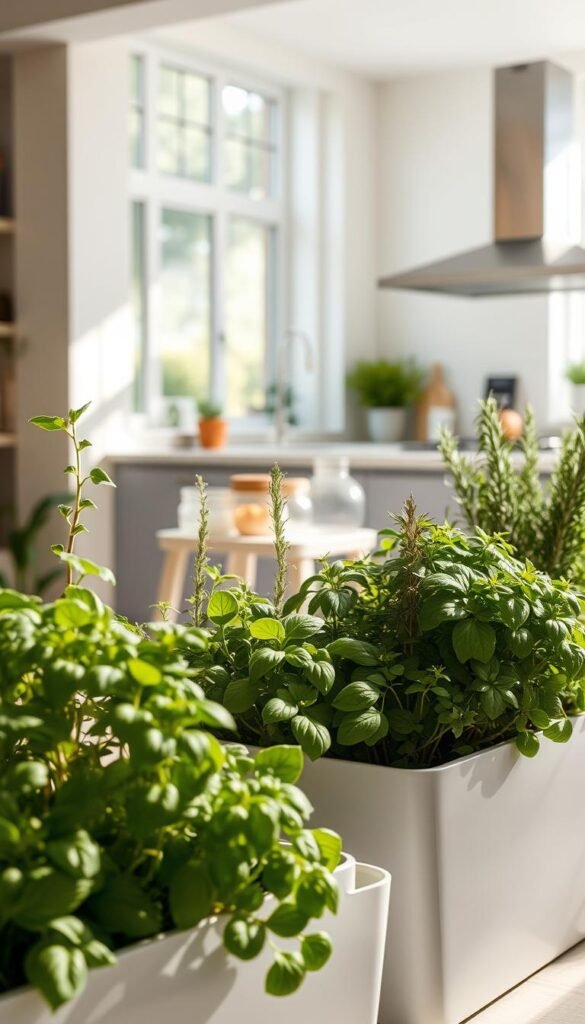
Fresh flavors don’t hibernate—keep your dishes vibrant even in colder months. When frost blankets outdoor spaces, your herb garden thrives indoors, delivering peppery basil or earthy rosemary for winter stews. No more last-minute store runs: aromatic sprigs grow steps from your cutting board.
Homegrown options pack more punch than store-bought counterparts. Leaves retain essential oils that fade during shipping, giving sauces and marinades boldness you can’t replicate with dried jars. One basil plant yields 10x more harvests than a $4 supermarket pack.
| Feature | Homegrown Herbs | Store-Bought |
|---|---|---|
| Availability | Year-round | Seasonal |
| Flavor | Peak freshness | Often wilted |
| Cost | $3 per plant | $3 per bunch |
Small-space solutions like container gardening hacks let you maximize windowsills. Tending plants becomes a stress-relieving ritual—their growth mirrors your care. Plus, you control what goes into the soil, avoiding unwanted chemicals.
Your meals gain personality with varieties like spicy oregano or citrusy thyme. Every snip connects you to the food’s journey, from soil to plate. Why settle for less when flavor thrives at home?
Essential Elements for a Thriving Kitchen Herb Garden
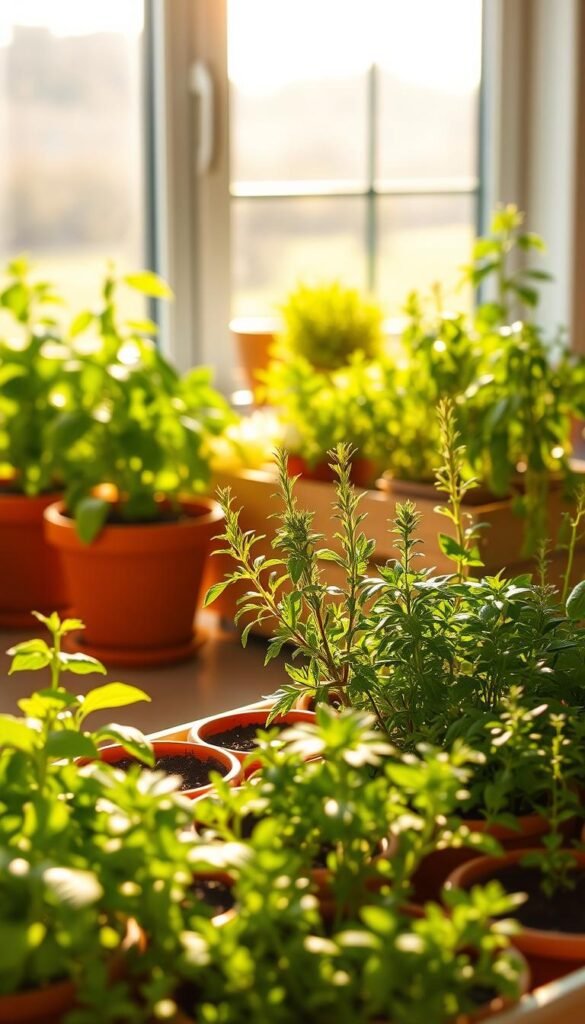
Light transforms ordinary leaves into flavor powerhouses. Your green companions need strategic placement to unlock their full potential—it’s not just about finding any bright spot, but the right one.
Choosing the Right Location
South-facing windows bathe plants in steady light all day—ideal for sun-loving varieties like rosemary. West-facing spots deliver intense afternoon rays, perfect for basil’s growth spurts. Observe your space for 2-3 days to map sunlight patterns.
| Window Direction | Light Hours | Best For |
|---|---|---|
| South | 6-8 hours | Mediterranean herbs |
| West | 4-6 hours | Leafy varieties |
| East | Morning light | Delicate plants |
| North | Low light | Supplement with grow lights |
Identifying Key Growing Factors
While light tops the list, three other elements matter. Keep temperatures between 65-75°F—avoid drafty areas near doors. Rotate pots weekly so all sides get equal sun exposure.
Humidity levels impact leaf texture. Group plants together to create a moisture-rich microclimate. A small fan nearby improves air flow, preventing mold in dense foliage.
Remember: even low-light spots can work. Mint and parsley tolerate shade better than most. Match species to your conditions, and you’ll harvest vibrant flavors effortlessly.
Kitchen Herb Garden Indoor: Cooking with Fresh Flavors All Year Long
Your cutting board deserves better than dried spices from the back of the pantry. Positioning plants near prep areas lets you grab what you need mid-sauté—no frantic fridge searches required. This setup turns meal-making into a fluid dance between stove and sill.
Snip-and-go access changes everything. Recipes gain spontaneity when basil or thyme grows three feet from your knife. You’ll use more greens because they’re right there, brightening scrambled eggs or garnishing soups effortlessly.
Store-bought options lose 40% of their essential oils within hours of harvest. Homegrown herbs retain these oils, delivering richer flavors in every bite. A single rosemary sprig from your windowsill can outshine an entire supermarket bunch.
Consistency matters too. Outdoor gardens battle frost and pests, but indoor plants thrive under steady conditions. Your chimichurri will taste just as zesty in January as it did in July.
This way of growing connects you to meals meaningfully. You’ll waste less—only harvest what you need—and save $150+ annually on pricey plastic packs. Plus, watching those green stems flourish? That’s satisfaction no grocery aisle can match.
Selecting the Best Herbs for Indoor Gardening
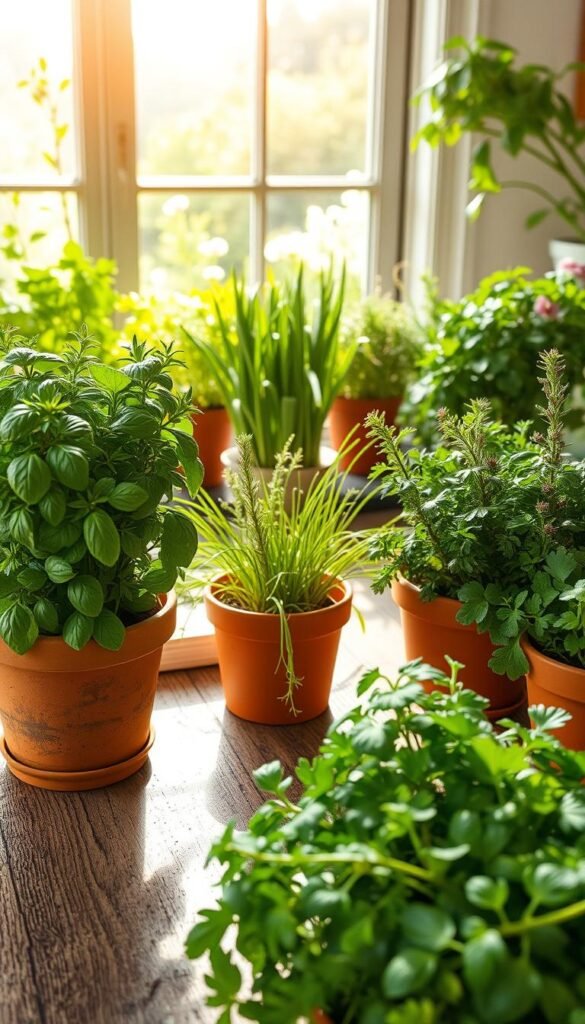
Your windowsill becomes a flavor laboratory when stocked with the right green companions. Focus on resilient plants that tolerate indoor conditions while delivering bold tastes. These selections thrive in containers and forgive occasional lapses in care – perfect for busy gardeners.
Top Starter Varieties for Success
Begin with these low-fuss champions:
- Basil: Loves warmth and bright light
- Mint (spearmint/peppermint): Grows vigorously in partial sun
- Chives: Produces onion-flavored leaves year-round
- Parsley: Offers flat or curly leaf options
| Herb | Light Needs | Growth Speed | Key Use |
|---|---|---|---|
| Rosemary | Full sun | Slow | Roasts & marinades |
| Thyme | Moderate | Medium | Soups & stews |
| Cilantro | Bright indirect | Fast | Salsas & curries |
| Oregano | Direct sun | Medium | Pizza & pasta |
Maximizing Flavor Potential
Each herb brings unique notes to dishes. Basil’s sweet peppery leaves elevate caprese salads, while mint adds freshness to drinks. For Mediterranean flair, try rosemary’s pine-like aroma in roasted vegetables.
Chives work wonders in omelets – snip the hollow leaves just before serving. Prefer Asian cuisine? Coriander’s citrusy punch enhances pho and stir-fries. Match your varieties to favorite recipes for maximum impact.
Discover more tips for a successful indoor herb setup. With these selections, you’ll transform everyday meals into culinary adventures using sprigs grown steps from your stove.
Choosing the Perfect Containers and Planters
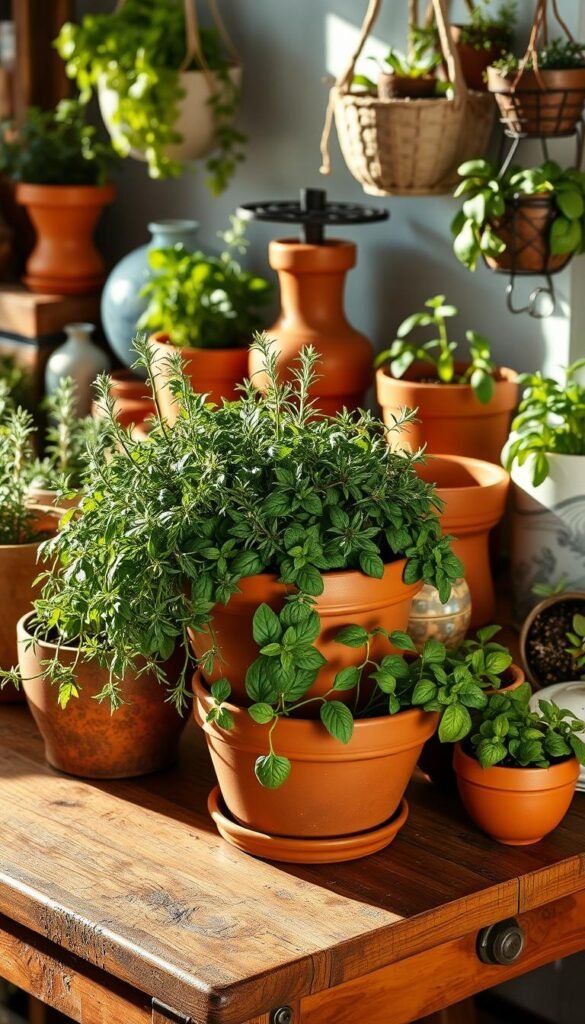
The vessel holding your green treasures impacts their growth as much as sunlight or water. Your chosen containers become mini ecosystems – their material and design influence moisture levels, root health, and even leaf flavor intensity. Start simple: a $4 terracotta pot with drainage holes often outperforms fancy alternatives.
Material Matters: Classic to Creative
Terracotta pots breathe naturally, preventing soggy roots while adding earthy charm. Their porous walls wick away excess moisture – perfect for rosemary or thyme. Ceramic containers offer bold color choices but need saucers to protect surfaces from water stains.
| Container Type | Best For | Drainage | Cost |
|---|---|---|---|
| Terracotta | Mediterranean herbs | Excellent | $ |
| Ceramic | Decorative displays | Moderate | $$ |
| Upcycled | Budget projects | Variable | Free |
| Self-watering | Busy lifestyles | Controlled | $$$ |
Smart Solutions for Consistent Care
Self-watering options use reservoirs to keep soil evenly moist for 7-10 days. Ideal for basil’s thirst or when work trips interrupt routines. Pair them with moisture meters for precision watering without guesswork.
Got empty mason jars or tin cans? Drill holes in the bottom for instant containers. Upcycled planters save money and reduce waste – just ensure they’re deep enough for roots to spread comfortably.
Remember: drainage remains non-negotiable. Whether using a repurposed coffee tin or sleek ceramic pot, excess water must escape freely. Layer pebbles at the base if your container lacks proper drainage holes.
Understanding Soil, Compost, and Drainage
The secret to vibrant herbs lies beneath the surface. Your plants’ performance depends on a balanced trio: soil structure, nutrient-rich additives, and reliable drainage. Think of these elements as your green allies’ support system – get them right, and growth becomes effortless.
Start with organic potting mix as your base. These blends contain peat moss or coconut coir for moisture control, plus perlite for air pockets. “Soil isn’t just dirt – it’s a living ecosystem,” notes urban gardener Lisa Tran. “Feed it well, and your herbs repay you tenfold.”
Boost your mix with 20% compost for slow-release nutrients. More than that risks waterlogging – roots need breathing room. A 4:1 ratio (mix to compost) creates the perfect crumbly texture. Worm castings work wonders too, adding beneficial microbes without compaction.
Drainage holes are non-negotiable. No holes? Create a 1-inch layer of pebbles at the bottom. This simple hack prevents soggy roots while letting excess water escape. Test your setup: water should flow freely through the container within 30 seconds.
| Component | Purpose | Ideal % |
|---|---|---|
| Potting Mix | Base structure | 80% |
| Compost | Nutrient source | 20% |
| Drainage Layer | Prevents rot | 1-2 inches |
Healthy roots mean robust growth. When soil stays too wet, oxygen-starved roots suffocate. Check moisture with the finger test: if the top inch feels dry, water thoroughly. Your herbs will reward you with leaves that burst with essential oils.
Watering Strategies for Indoor Herbs
Mastering moisture levels transforms thirsty sprouts into lush, aromatic greens. While some plants prefer sipping lightly, others thrive with regular drinks. Learning their language prevents crispy leaves or soggy stems.
Determining Watering Frequency
Check soil before reaching for your watering can. Push a finger an inch deep—if it feels cool, wait. Basil might need weekly drinks, while rosemary prefers drying out completely between sessions.
Winter changes routines. Lower light slows growth, so cut water by 30-40%. Watch for drooping leaves signaling thirst. Lighter pots often mean drier soil—lift them to gauge needs.
Preventing Root Rot and Overwatering
Soggy soil suffocates roots. Ensure containers drain freely, and empty saucers after 15 minutes. Yellowing lower leaves often warn of root trouble. Let the topsoil breathe between waterings.
Terracotta pots help balance moisture naturally. For herbs prone to dampness, mix perlite into soil. Remember: it’s easier to add water than fix drowned plants. Your green allies will flourish with this mindful approach.

